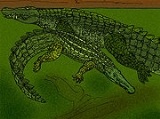
Harpacochampsa
Encyclopedia
Harpacochampsa camfieldensis is a poorly known Early Miocene
crocodilian from the Bullock Creek
lagerstatte
of the Northern Territory
. The current specimen consists of a partial skull and fragments of a slender snout reminiscent of that of a false gharial
. It is tentatively placed within Mekosuchinae
, though some experts disagree with this, as H. camfieldensis would be the only known mekosuchine with a long, thin snout. Its long snout demonstrates that it was a piscivore
in life.
Miocene
The Miocene is a geological epoch of the Neogene Period and extends from about . The Miocene was named by Sir Charles Lyell. Its name comes from the Greek words and and means "less recent" because it has 18% fewer modern sea invertebrates than the Pliocene. The Miocene follows the Oligocene...
crocodilian from the Bullock Creek
Bullock Creek
The Bullock Creek Fossil site is one of three known vertebrate fossil sites in the Australia's Northern Territory, along with the Alcoota Fossil Beds on Alcoota Station and the Kangaroo Well site on Deep Well Station. It is located about 550km south-southeast of Darwin, on Camfield Station...
lagerstatte
Lagerstätte
A Lagerstätte is a sedimentary deposit that exhibits extraordinary fossil richness or completeness.Palaeontologists distinguish two kinds....
of the Northern Territory
Northern Territory
The Northern Territory is a federal territory of Australia, occupying much of the centre of the mainland continent, as well as the central northern regions...
. The current specimen consists of a partial skull and fragments of a slender snout reminiscent of that of a false gharial
False gharial
The false gharial , also known as the Malayan gharial, false gavial, or Tomistoma is a freshwater crocodile of the Crocodylidae family with a very thin and elongated snout...
. It is tentatively placed within Mekosuchinae
Mekosuchinae
Mekosuchinae was a subfamily of crocodiles from Australia and the South Pacific that have now become extinct. They first appear in the fossil record in the Eocene in Australia, and survived until the Pleistocene in Australia and until the arrival of humans in the Pacific islands of Fiji, New...
, though some experts disagree with this, as H. camfieldensis would be the only known mekosuchine with a long, thin snout. Its long snout demonstrates that it was a piscivore
Piscivore
A piscivore is a carnivorous animal which eats primarily fish. Piscivory was the diet of early tetrapods , insectivory came next, then in time reptiles added herbivory....
in life.

